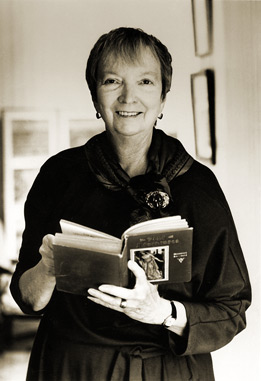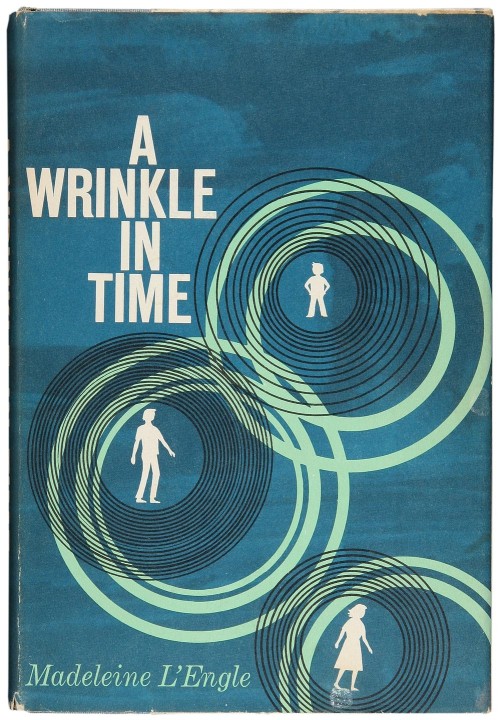“A Wrinkle in Time” by Madeleine L’Engle. New York, NY: Farrar, Straus and Giroux, 1962.
 Madeleine L’Engle believed in writing for people:
Madeleine L’Engle believed in writing for people:
“You have to write the book that wants to be written. And if the book will be too difficult for grown-ups, then you write it for children.”
After “A Wrinkle in Time” had been rejected by 26 publishers, a friend introduced L’Engle to John Farrar of Farrar, Straus and Giroux. Farrar had read L’Engle’s other books and was delighted to work on her new novel. Despite the publisher’s enthusiasm for the book, L’Engle noted their caution in her memoir, “A Circle of Quiet”: “Don’t be disappointed if it doesn’t do well . . . We’re publishing it because we love it.”
“A Wrinkle in Time” follows the time travel adventures of thirteen-year-old Meg, her little genius brother Charles Wallace and their new friend Calvin O’Keefe. The trio embark on a journey to find Meg and Charles’s father, a scientist who has been mysteriously missing for several years. The unforgettable Mrs. Whatsit, Mrs. Who and Mrs. Which assist them on their travels through space and time.
 Madeleine L’Engle wrote “A Wrinkle in Time” between 1950 and 1960 after reading about quantum physics. Besides the space-time concept, L’Engle immerses her readers in a world controlled by one brain where its citizens work and play in unison. “The Dark Thing”–a mysterious presence affecting some planets and not others—presents questions of good and evil. All the while, Mrs. Who lends her philosophical wisdom to the time travelers in the form of famous quotes and common sense advice—only she first delivers the phrase in its original language—Latin, French, Italian, German, Greek. Early readers of the manuscript doubted a children’s book could successfully carry such heavy themes.
Madeleine L’Engle wrote “A Wrinkle in Time” between 1950 and 1960 after reading about quantum physics. Besides the space-time concept, L’Engle immerses her readers in a world controlled by one brain where its citizens work and play in unison. “The Dark Thing”–a mysterious presence affecting some planets and not others—presents questions of good and evil. All the while, Mrs. Who lends her philosophical wisdom to the time travelers in the form of famous quotes and common sense advice—only she first delivers the phrase in its original language—Latin, French, Italian, German, Greek. Early readers of the manuscript doubted a children’s book could successfully carry such heavy themes.
Since the book’s publication in 1962, “A Wrinkle in Time” has never gone out of print and has sold more than 14 million copies. The book also won the Newbery Medal for the Most Distinguished Contribution to American Literature for Children.
 Collecting children’s literature can be difficult for the simple reason that children are reading and loving these pages, and finding copies in fine condition can be a challenge. Today a signed first edition of “A Wrinkle in Time” is a rare find and would be worth a year’s college education!
Collecting children’s literature can be difficult for the simple reason that children are reading and loving these pages, and finding copies in fine condition can be a challenge. Today a signed first edition of “A Wrinkle in Time” is a rare find and would be worth a year’s college education!
Special collector’s editions offer another way to collect this classic. The 25th anniversary edition of “A Wrinkle in Time” was released by Farrar, Straus and Giroux in 1987 in a signed limited edition of 500 copies. The book is cloth bound with gilt lettering and housed in a red cloth slipcase. The book recently celebrated its 50th anniversary in 2012 with another special edition. A film adaptation of “A Wrinkle in Time” is also in the works, and L’Engle’s granddaughter recently released three unpublished manuscript pages to The Wall Street Journal which highlight the book’s political and philosophical commentary. The love and relevance of “A Wrinkle in Time” continues to grow strong.
Written by Lisa Newman, A version of this column was published in The Clarion-Ledger’s Sunday Mississippi Books page.


Comments are closed.